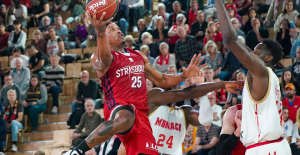With a growth in generosity of 1% in 2022, it is quite simply “the lowest annual evolution of donations” recorded “for 10 years”, reveals the barometer of generosity 2022 carried out by Novos for France generosities with the support of La Banque Postale and unveiled this Wednesday. A weak progression which “does not compensate for the effect of inflation on associations and foundations” underlines the study. The smallest donations between 0 and 150 euros even “dropped by 6.9%”, just caught up by a “5.5% increase” in the portion of donations above 1,500 euros.
Each year, new donors become increasingly rare (-11.2% between 2012 and 2022). To deal with it, Pierre Siquier, the president of France generosities, calls for “redouble efforts” in order to “awaken” charity. Is the dematerialization of payments and current consumption patterns signaling the end of the traditional gift, as it has always existed? For several years, new forms of donations have been emerging to meet today's uses and modernize the sector.
First there was the micro-donation, which consists in offering customers of a business or a supermarket to round up the bill to the next euro, and this, from a payment terminal (TPE) . They then just have to say yes or no, before entering their code. This dematerialized donation system, known as "l'Arrondi", is available at Fnac, Sephora, Galeries Lafayette, Leroy Merlin TPEs or in Picard and Monoprix group stores, to name a few. than them. In total, more than 50 million euros have been collected in ten years and this for more than a thousand associations.
At the same time, some parishes were embarking on the dematerialization of the quest, by offering - in addition to the traditional wicker basket - to participate via a connected basket. A system of "contactless, easy, fast and anonymous payment", "practical alternative to the traditional basket, faced with the increasing dematerialization of means of payment", according to the diocese of Paris which has democratized this system in 80% of parishes, i.e. 86 churches in the capital. A way for the Church to “adapt to these new technologies and to creatively welcome new uses”.
According to Marc Naudet, innovation and financial resources manager of the diocese, these dematerialized collection baskets have thus made it possible to collect no less than 1.8 million euros in 2022, corresponding to 17% of the total amount of the collection in the diocese for a average donation basket at 6.4 euros. A share that continues to increase according to him: "We recover the parishioners who do not necessarily have change or those who put in small coins and who are now offered much larger amounts".
Other systems had also been designed to get as close as possible to potential donors, like the donation terminals installed in the Paris metro. To do this, screens equipped with NFC sensors, a contactless payment technology, were directly integrated into the landing doors of line 1 in particular. It was then enough to affix his bank card to make a donation of two or five euros, for the Restos au cœur, then, the day after the fire of Notre-Dame de Paris, to help with the reconstruction of the cathedral. An experiment that was ultimately not extended.
But if these methods have the advantage of facilitating the act of donation, the fact remains that it does not leave the choice to the interested party to choose the association to which he wishes to donate. This is precisely what Njara Zafimehy, founder and CEO of WhatRocks, points out, who has developed a system of solidarity donations via a cryptocurrency called “Rock”. The principle is simple: after downloading the dedicated application, the user can earn "Rocks" - by going to a business or a partner restaurant, by watching an advertisement or by reading a newsletter - which he can then donate to one or more of the 200 associations in France and abroad of their choice.
"It's the brands that use their marketing budget to buy these cryptocurrencies and then redistribute them (...) Consumers take no risk, the app is free and they never need to give their credit card number" , explains Njara Zafimehy. On the one hand, it allows partner companies - Maison Kayser, Nature
Others intend to surf on their reputation to weigh in the balance of solidarity giving. This is the case of Leetchi, the leader in online pots, which aims to “become the benchmark for solidarity collection”. "Associations are seeing declining donations, but the French continue to mobilize very strongly for the causes that are close to their hearts", assures Alix Poulet, CEO of Leetchi, who argues that in 2022, 250 million euros were collected. via its platform, including 60 million for solidarity projects. This rise in solidarity kitties “started in 2015 in the aftermath of the Charlie Hebdo attacks”, and continued – according to her – “to support victims of the Covid-19 crisis or the war in Ukraine”. Or even in order to "help the strikers engaged against the pension reform in financial difficulty".
This new form of charity carries “the desire to be an accelerator of these citizen mobilizations” and aims to “facilitate the impulses in favor of young people”, according to Leetchi. How ? For example, by offering “a free level for prize pools of less than 100 euros and a levy which has gone from 2.9% to 1.5% for prize pools of more than 10,000 euros”. In addition, the company has not hesitated to contribute to certain projects, such as that carried out by Delivr'aide, the first delivery platform for food and hygiene kits for precarious young people. “The kitty had reached 42,000 euros in a few days and we had participated ourselves by financing 100 additional kits”, explains Alix Poulet.
This trend towards the digitization of generosity practices “is expressed particularly in emergencies” but “is also noted in the overall collection (excluding emergencies)”, welcomes France generosities, which affirms that the share of online donations now represents 26 .8% of the collection of one-off donations in 2022, compared to 18.8% in 2019. So don't panic if generosity is somewhat at half mast because, according to the 2022 generosity barometer, this does not seem to affect digital collection which "continues to grow" with an increase in online donations of 60% in 3 years.

 War in Ukraine: when kyiv attacks Russia with inflatable balloons loaded with explosives
War in Ukraine: when kyiv attacks Russia with inflatable balloons loaded with explosives United States: divided on the question of presidential immunity, the Supreme Court offers respite to Trump
United States: divided on the question of presidential immunity, the Supreme Court offers respite to Trump Maurizio Molinari: “the Scurati affair, a European injury”
Maurizio Molinari: “the Scurati affair, a European injury” Hamas-Israel war: US begins construction of pier in Gaza
Hamas-Israel war: US begins construction of pier in Gaza First three cases of “native” cholera confirmed in Mayotte
First three cases of “native” cholera confirmed in Mayotte Meningitis: compulsory vaccination for babies will be extended in 2025
Meningitis: compulsory vaccination for babies will be extended in 2025 Spain is the country in the European Union with the most overqualified workers for their jobs
Spain is the country in the European Union with the most overqualified workers for their jobs Parvovirus alert, the “fifth disease” of children which has already caused the death of five babies in 2024
Parvovirus alert, the “fifth disease” of children which has already caused the death of five babies in 2024 Inflation rebounds in March in the United States, a few days before the Fed meeting
Inflation rebounds in March in the United States, a few days before the Fed meeting Video games: Blizzard cancels Blizzcon 2024, its annual high mass
Video games: Blizzard cancels Blizzcon 2024, its annual high mass Falling wings of the Moulin Rouge: who will pay for the repairs?
Falling wings of the Moulin Rouge: who will pay for the repairs? “You don’t sell a company like that”: Roland Lescure “annoyed” by the prospect of a sale of Biogaran
“You don’t sell a company like that”: Roland Lescure “annoyed” by the prospect of a sale of Biogaran Exhibition: in Deauville, Zao Wou-Ki, beauty in all things
Exhibition: in Deauville, Zao Wou-Ki, beauty in all things Dak’art, the most important biennial of African art, postponed due to lack of funding
Dak’art, the most important biennial of African art, postponed due to lack of funding In Deadpool and Wolverine, Ryan and Hugh Jackman explore the depths of the Marvel multiverse
In Deadpool and Wolverine, Ryan and Hugh Jackman explore the depths of the Marvel multiverse Tom Cruise returns to Paris for the filming of Mission Impossible 8
Tom Cruise returns to Paris for the filming of Mission Impossible 8 Skoda Kodiaq 2024: a 'beast' plug-in hybrid SUV
Skoda Kodiaq 2024: a 'beast' plug-in hybrid SUV Tesla launches a new Model Y with 600 km of autonomy at a "more accessible price"
Tesla launches a new Model Y with 600 km of autonomy at a "more accessible price" The 10 best-selling cars in March 2024 in Spain: sales fall due to Easter
The 10 best-selling cars in March 2024 in Spain: sales fall due to Easter A private jet company buys more than 100 flying cars
A private jet company buys more than 100 flying cars This is how housing prices have changed in Spain in the last decade
This is how housing prices have changed in Spain in the last decade The home mortgage firm drops 10% in January and interest soars to 3.46%
The home mortgage firm drops 10% in January and interest soars to 3.46% The jewel of the Rocío de Nagüeles urbanization: a dream villa in Marbella
The jewel of the Rocío de Nagüeles urbanization: a dream villa in Marbella Rental prices grow by 7.3% in February: where does it go up and where does it go down?
Rental prices grow by 7.3% in February: where does it go up and where does it go down? Even on a mission for NATO, the Charles-de-Gaulle remains under French control, Lecornu responds to Mélenchon
Even on a mission for NATO, the Charles-de-Gaulle remains under French control, Lecornu responds to Mélenchon “Deadly Europe”, “economic decline”, immigration… What to remember from Emmanuel Macron’s speech at the Sorbonne
“Deadly Europe”, “economic decline”, immigration… What to remember from Emmanuel Macron’s speech at the Sorbonne Sale of Biogaran: The Republicans write to Emmanuel Macron
Sale of Biogaran: The Republicans write to Emmanuel Macron Europeans: “All those who claim that we don’t need Europe are liars”, criticizes Bayrou
Europeans: “All those who claim that we don’t need Europe are liars”, criticizes Bayrou These French cities that will boycott the World Cup in Qatar
These French cities that will boycott the World Cup in Qatar Basketball: Strasbourg appeals the victory recovered by Monaco
Basketball: Strasbourg appeals the victory recovered by Monaco Top 14: UBB with Tatafu and Moefana against Bayonne
Top 14: UBB with Tatafu and Moefana against Bayonne MotoGP: Bagnaia dominates qualifying practice in Spain and sets track record
MotoGP: Bagnaia dominates qualifying practice in Spain and sets track record Olympic Games: in Athens, Greece transmits the Olympic flame to France
Olympic Games: in Athens, Greece transmits the Olympic flame to France


















